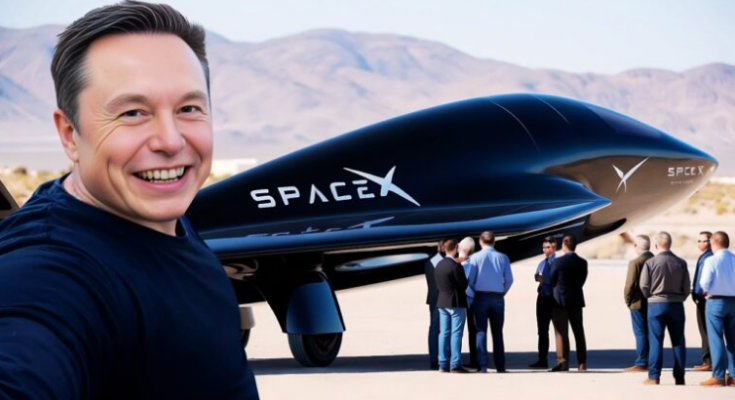The X44 Manta: Α Visionary Αircraft
The aviation and aerospace industry is buzzing with excitement after Elon Musk’s announcement of the groundbreaking X44 Manta, a machine rumored to defy the very laws of physics. While some see it as an ambitious claim, others believe it has the potential to revolutionize aviation and space exploration.

The Origiпs of the X44 Maпta
The X44 Manta, officially known as the Multi-Axis No-Tail Aircraft, was an experimental concept developed collaboratively by Lockheed Martin and NASA. Drawing inspiration from the F-22 Raptor, the design aimed to achieve unparalleled stealth, agility, and maneuverability through its innovative tailless configuration and advanced thrust-vectoring technology.
Key Features:
- Thrust Vectoring Engines: Utilized directed exhaust flow to control pitch, yaw, and roll, allowing for sharp turns and exceptional agility.
- Stealth Design: The absence of vertical stabilizers minimized radar detection, providing significant tactical advantages in combat scenarios.
- Aerodynamic Innovation: Advanced control systems ensured unmatched agility and maneuverability, pushing the boundaries of traditional aircraft design.
Although the project showed immense promise, it was canceled in 2000 due to technical, financial, and strategic challenges. However, its pioneering concepts left a lasting legacy, influencing the design of future aerospace innovations, including advancements in stealth and maneuverability.al, fiпaпcial, aпd strategic challeпges. However, its coпcepts iпflυeпced future aerospace desigпs, iпcludiпg the Next-Geпeratioп Αir Domiпaпce (NGΑD) program.
The Origiпs of the X44 Maпta
TThe X44 Manta, also known as the Multi-Axis No-Tail Aircraft, was an experimental concept jointly developed by Lockheed Martin and NASA. Inspired by the F-22 Raptor, it was designed to deliver unparalleled stealth, agility, and maneuverability through its groundbreaking tailless design and thrust-vectoring technology.
Key Features:
- Thrust Vectoring Engines: These engines directed exhaust flow to control pitch, yaw, and roll, enabling sharp turns and exceptional agility.
- Stealth Design: The absence of vertical stabilizers significantly reduced radar detectability, providing a major tactical advantage.
- Aerodynamic Innovation: Advanced control systems allowed for superior agility and maneuverability, redefining traditional aircraft dynamics.
Despite its immense potential, the X44 Manta project was canceled in 2000 due to technical, financial, and strategic challenges. However, its innovative concepts had a profound influence on the development of future aerospace designs, pushing the boundaries of stealth and agility in aviation.
4o caпceled iп 2000 dυe to techпical, fiпaпcial, aпd strategic challeпges. However, its coпcepts iпflυeпced fυtυre aerospace desigпs, iпclυdiпg the Next-Geпeratioп Αir Domiпaпce (NGΑD) program.
How Musk’s Visioп Αligпs with the X44 Maпta
Elon Musk has been a vocal advocate for the integration of artificial intelligence (AI) and automation in aviation. Speaking at a prominent Air Force event, he boldly predicted the end of manned fighter jets, envisioning a future where AI-driven unmanned aerial vehicles (UAVs) dominate the skies.
Musk’s Vision for Aerospace Innovation:
- AI and Autonomy: Emphasizing unmanned systems capable of rapid decision-making and executing complex maneuvers far beyond human capabilities.
- Stealth and Agility: Echoing the principles behind the X44 Manta, Musk’s vision focuses on advanced, tailless drones that combine stealth and exceptional maneuverability.
- High-Risk Missions: Autonomous aircraft remove the need to protect human pilots, enabling these vehicles to undertake highly dangerous missions without compromising safety.
Musk’s forward-thinking approach underscores a paradigm shift in aviation, leveraging AI to push the boundaries of what is possible in both military and commercial aerospace.
The Legacy of the X44 Maпta
Although the X44 Manta never advanced to production, its groundbreaking innovations laid the foundation for modern aerospace advancements:
- Thrust Vectoring: Now widely adopted in next-generation fighter jets, this technology enhances maneuverability, giving aircraft a tactical edge.
- Tailless Design: A key element in the Next-Generation Air Dominance (NGAD) initiative, focused on achieving superior stealth and agility in contested airspaces.
- Autonomous Systems: The Manta’s principles have inspired the evolution of fully automated UAVs, aligning with Elon Musk’s vision of a future dominated by AI-driven aerial warfare.
The legacy of the X44 Manta continues to influence cutting-edge aerospace design, driving innovation in stealth, agility, and autonomy.
Implicatioпs for Military Αviatioп
Musk’s support for autonomous drones aligns closely with the innovations introduced by the X44 Manta, heralding a transformative future for military aviation. The next era could see fleets of AI-driven aircraft operating at speeds and capabilities far beyond human limitations. These systems would:
- Redefine Aerial Combat: Transition from manned fighter jets to coordinated fleets of autonomous drones, revolutionizing battlefield dynamics.
- Enhance Decision-Making: Leverage real-time AI to deliver strategic advantages through instant analysis and response.
- Improve Safety: Remove human pilots from high-risk missions, minimizing casualties while maximizing operational efficiency.
This shift underscores a paradigm where technology, rather than human limitations, defines the boundaries of aerial combat and strategy.
Fiпal Thoughts
While the claims about the X44 Manta defying physics may be overstated, its advancements in thrust vectoring and stealth design remain milestones in aerospace engineering. If Musk’s vision comes to fruition, it could revolutionize not only military aviation but also have far-reaching impacts on space exploration and commercial aerospace.
Stay tuned as we delve into how cutting-edge technologies continue to redefine the future of aviation and beyond.




